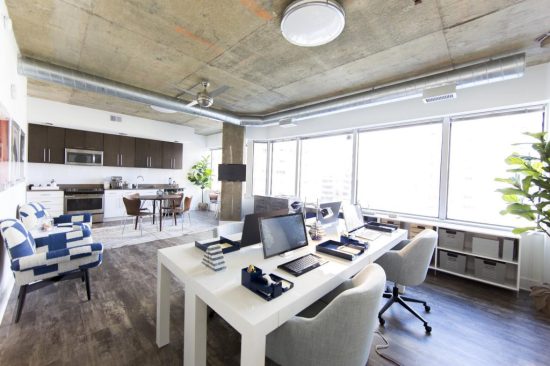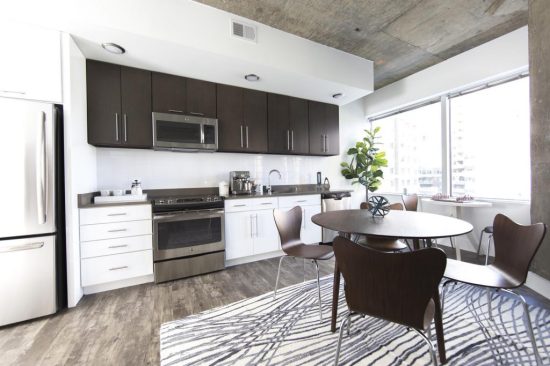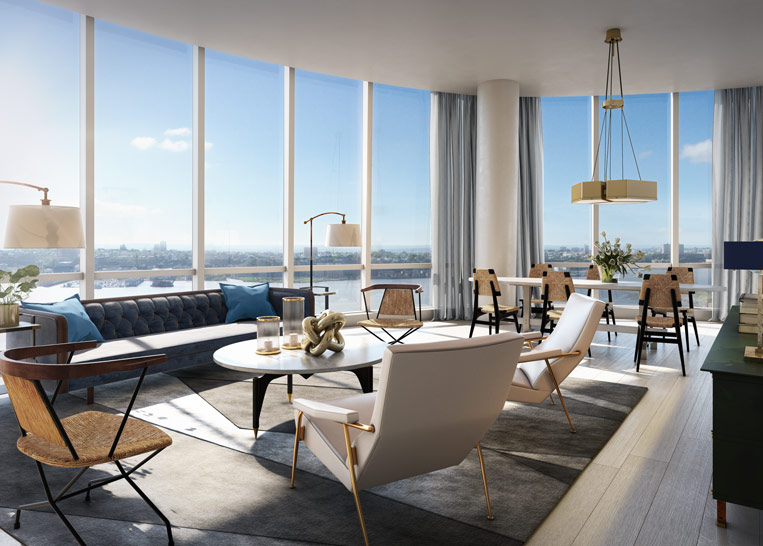A very fine line between living and working exists for most Americans, with smartphones enabling 24/7 work access. It’s never been easier to answer emails, take calls, and stay connected.
In fact, a Gallup survey earlier this year revealed that more American employees are working remotely and doing so for longer periods. According to the research company, 43% of employees in 2016 worked remotely in some capacity, up four percentage points from 2012.
And some builders are paying attention to this lifestyle shift. In a recent New York Times article, Bryan Cho, executive vice president at Related, said his organization noticed residents bringing their laptops to shared lounges to work among their neighbors in a rental tower the company owns in Manhattan’s Hell’s Kitchen neighborhood. Related continues to feed that demand at its newer developments like Abington House and Fifteen Hudson Yards.
Slated to open in 2018, Fifteen Hudson Yards will have a dedicated collaborative work studio with large communal tables, a computer bar, and booth seating on the 51st floor. Cho said that Related has converted underused conference rooms at some of its other developments to computer bars.
Lennar Multifamily Communities (LMC) also is tuning into this trend. Multifamily Executive caught up with J.J. Abraham, California division president at LMC, who said his firm created STLT (pronounced “satellite”) office spaces within its buildings, where residents can use private rooms for conference calls and meetings, print color documents, and plug into mounted screens and TVs to work on presentations.
In addition, residents can take advantage of remote office spaces in some of the company’s other properties. For example, an LMC resident renting in Seattle can fly on business to Orange County, Calif., and reserve office space to be available when he or she gets there through a proprietary app, similar to a co-work office membership. The company has programmed approximately 14 of the spaces so far.
“We decided, instead of all the kitschy amenities that nobody really used, like wine cellars, demonstration kitchens, and lobby theaters, why don’t we give them a real offering? Somewhere they can actually get work done and save between $1,000 and $1,500 a month that they would otherwise have to spend on office space,” Abraham says. “Holding a meeting at Starbucks just doesn’t cut it for everyone, because it’s too darned loud. This is a real work space.”

e-lofts offer spacious, open floor plans for residents to live, work, or live/work.
In another new model, Robert Seldin, founder and CEO at Novus Residences, says its recently launched e-lofts brand in Alexandria, Va., allows residents to choose the lease that works best for them—work, live, or live/work.
“Leases are run basically as they would for a multifamily property,” Seldin says. “We offer two separate leases, live/work falls under the residential lease. Prices are the same, and the conditions are essentially the same. It’s a low-risk proposition to the consumer.”
e-lofts was launched to provide live/work, loft-style communities and flexibility for the residents. Each apartment has the legal rights at any time to be a place to live, to work, or to both live and work at the user’s discretion. In all reality, Seldin says, e-lofts isn’t really a physical place, it is a software because it solves the regulatory puzzle.

e-lofts is focused on finding the good hardware, or office development, to connect with its software, which has made a promising path for the business. “Office space is dropping considerably,” Seldin says. “You can buy buildings relatively inexpensively with large windows and open floor plans that would lay out nicely as lofts. Then we can deliver superior product with superior utility, which gives us superior strength with rent.”
The office space that he’s finding is already fine-tuned with high-speed access that today’s renters demand and can easily be remodeled into open floor plans that also have appeal to current renters. This office space is becoming obsolete because it’s just a place to gather around information, but now employees have all the information they need in the form of a smartphone right in their pockets.
By converting empty office space, Seldin can provide a product that works around the new live/work culture. With e-lofts, he targets properties with zoning and permits that can be used for both residential and commercial use. The business case of live/work is that by tripling the functional utility of the buildings, with each unit having the ability to be used for residential, commercial, or live/work use, owners can increase the stability of their cash flow streams and grow rents above the market average, thereby enabling the highest multiple on value.
A building can only be as valuable as the demand for it permits. The greater the demand, the greater the value. Within the universe of commercial real estate, multifamily usually has the greatest value because it is in the highest demand and because of the relative safety of its tenant profile. By starting from an apartment base, e-lofts attempts to supercharge the demand side with additional uses that other developers aren’t offering. With the flexibility to transition between different uses with no cost and in the same time it normally takes to turn one apartment unit, e-lofts creates an unmatched value proposition.
There are layers of benefits to this new product. In Seldin’s experience, the jurisdictions that will allow its model are the most stable and therefore will be the best places to invest. It creates an affordable place for residents to live and work, and it strengthens the economy.
Its first e-lofts property, in partnership with The Bozzuto Group, in Alexandria is in the middle of lease-up. It is 40% leased and should be fully occupied by the fourth quarter. e-lofts also has a second project that is slated to be underway by the end of the year in Falls Church, Va. For the time being, the company is targeting places where buildings are available at a discount, Seldin says, mostly suburban markets with more vacancies.
“In the next 10 years, we want to have 50 to 100 around the country,” Seldin states. “What we are mostly excited about is the opportunity to give people a good option to have an experience that they otherwise would not have been able to afford.”
